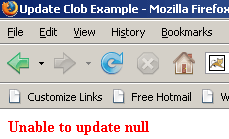Servlet Example To Update Mysql Clob Data
This example shows how to update CLOB data in the database. In our example, servlet InsertClobExample takes url for the CLOB data (the url will be pointing to a text file). Therefore, we will represent the CLOB as a url.
Mysql Clob
According to the Mysql, there are four text types TINYTEXT, TEXT, MEDIUMTEXT and LONGTEXT which can be taken as CLOB type and have the maximum lengths and storage requirements. The maximum length of TINYTEXT has 255 character (8 bits), TEXT has 16,535 character (16 bits), MEDIUMTEXT has 16,777,216 character (24 bits) and LONGTEXT has 4,294,967,295 character (32 bits).
Table 'article' in Mysql:
The structure of the table 'article' is as follows:
| CREATE TABLE `article` ( `ID` int(11) NOT NULL, `Subject` varchar(256) NOT NULL, `Body` longtext, PRIMARY KEY (`ID`) ) ENGINE=InnoDB DEFAULT CHARSET=latin1 |
Creating 'UpdateClobExample' servlet:
The following servlet UpdateClobExample shows how to update data of CLOB type in mysql database through the servlet program. It has two variables:
- id (the ID of file).
- sourceURL (the url of file representing the CLOB; the servlet will open the url, construct a CLOB and update it into the CLOB column of the article table)
Let's update a new record with the following data in the 'article' table:
- id (1)
- sourceURL (http://localhost:8080/JavaExample/images/large.dat)
Source code of UpdateClobExample.java
import java.io.*;
import java.util.*;
import javax.sql.*;
import javax.servlet.*;
import javax.servlet.http.*;
import java.sql.Connection;
import java.sql.DriverManager;
import java.sql.ResultSet;
import java.sql.SQLException;
import java.net.URL;
import java.io.IOException;
import java.io.InputStream;
import java.net.URLConnection;
import java.sql.PreparedStatement;
import java.io.ByteArrayOutputStream;
import javax.servlet.ServletException;
import javax.servlet.ServletOutputStream;
import javax.servlet.http.HttpServlet;
import javax.servlet.http.HttpServletRequest;
import javax.servlet.http.HttpServletResponse;
public class UpdateClobExample extends HttpServlet {
public void doGet(HttpServletRequest request, HttpServletResponse response)
throws IOException,ServletException {
response.setContentType("text/html");
String clobData = null;
Connection con = null;
Integer id = 1;
String sourceURL = "http://fddfg:8080/JavaExample/images/large.dat";
ServletOutputStream out = response.getOutputStream();
out.println("<html><head><title>Update Clob Example</title></head>");
try {
Class.forName("com.mysql.jdbc.Driver");
con =DriverManager.getConnection ("jdbc:mysql://192.168.10.59:3306/
example","root", "root");
clobData = getClobDataAsString(sourceURL);
updateClob(con, id, clobData);
out.println("<body><h4><font color='green'>Successfully update Your
Record with id=" + id + "</font></h4></body></html>");
} catch (Exception e) {
e.printStackTrace();
out.println("<body><h4><font color='red'>Unable to update "
+ e.getMessage() + "</font></h4></body></html>");
}
}
public void updateClob(Connection con, Integer id, String fileData)
throws Exception{
PreparedStatement ps = null;
try {
ps = con.prepareStatement("update article set body = ? where id = ?");
ps.setInt(2, id);
ps.setString(1, fileData);
ps.executeUpdate();
}catch(Exception e){
System.out.println(e);
}finally {
ps.close();
}
}
public static String getClobDataAsString(String urlData) throws Exception {
InputStream is = null;
try {
URL url = new URL(urlData);
System.out.println("url"+url);
URLConnection urlConn = url.openConnection();
urlConn.connect();
is = urlConn.getInputStream();
int BUFFER_SIZE = 1024;
ByteArrayOutputStream output = new ByteArrayOutputStream();
int length;
byte[] buffer = new byte[BUFFER_SIZE];
while ((length = is.read(buffer)) != -1) {
output.write(buffer, 0, length);
}
return new String(output.toByteArray());
} finally {
is.close();
}
}
}
Mapping of servlet (UpdateClobExample) in web.xml file:
|
<servlet> |
Run the servlet (UpdateClobExample.java) on this url: http://localhost:8080/JavaExample/UpdateClobExample.

In case of any error in the database connection then the following error message will be displayed.



